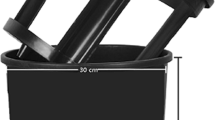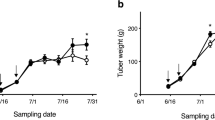Abstract
The effect of 2,4-D on tuberization, yield and the starch content of potato tubers produced on stem segments was examined. Potato stem segments were cultured in nutrient agar containing 2,4-D concentrations ranging from 10−7 M to 2 × 10−3 M. The stem segments were incubated in the dark at 25° C and examined after 15 days. The degree of tuberization on stem segments cultured in media containing 10−7 M and 10−6 M 2,4-D was higher than on the control stem segments. Mainly long stolons were observed on stem segments cultured in media containing 10−4 M and 2 × 10−3 M 2,4-D. The percent starch (dry wt. basis) in stolons was higher than that in tubers. However, the total starch content of tubers per stem segment cultured in media containing 10−7 M and 10−6 M 2,4-D was significantly higher than that of stolons obtained from stem segments cultured in media containing higher concentrations of 2,4-D. The total starch content of tubers, except those produced on stem segments cultured in media containing 10−7 M 2,4-D, decreased steadily with increasing concentration of 2,4-D in the culture media.
Resumen
Se estudió el efecto de 2,4-D en la tuberización, rendimiento y contenido de almidón de tubérculos de papa producidos en segmentos de tallo. Los segmentos de tallo de papa fueron cultivados en medio nutritivo de agar con concentraciones de 2,4-D variando de 10−7 M a 2 × 10−3 M. Los segmentos de tallo fueron inoculados en la oscuridad a 25°C y analizados después de 15 días. El grado de tuberización en segmentos de tallos cultivados en medios con 10−7 M y 10−6 M de 2,4-D fue mayor que con los segmentos de tallos usados como testigo. Se observaron estolones largos principalmente en segmentos de tallos cultivados en medios con 10−4 M y 2 × 10−3 M de 2,4-D. El porcentaje de almidón (en base a peso seco) en estolones fue mayor que en tubérculos. Sin embargo, el contenido total de almidón de tubérculos por segmento de tallo cultivados en medios que contenían 10−7 M y 10−6 M de 2,4-D fue significativamente mayor que aquellos de estolones obtenidos de segmentos de tallo cultivados en medios con concentraciones mayores de 2,4-D. El contenido total de almidón de los tubérculos, excepto aquellos producidos en segmentos de tallo cultivados en medio con concentración 10−7 M de 2,4-D, disminuyó uniformemente a medida que aumentaron las concentraciones de 2,4-D en el medio de cultivo.
Similar content being viewed by others
Literature Cited
Bradley, R.H. and N.K. Ellis. 1948. The effect of different rates of application of 2,4-D on the yield of potatoes. Am Potato J 25: 87–89.
Bristol, D.W., D.C. Nelson and L.W. Cook. 1981. Residues and dissipation of 2,4-D and 2,4-DCP in potato tubers. Am Potato J 58:143–151.
Danielson, L.L. 1948. Weeding Irish Cobbler potatoes with 2,4-D. Am Potato J 26:1–7.
Deacon, A.C. and P.P. Rutherford. 1972. Response of dandelion root tissue to treatment with 2,4- and 3,5-dichlorophenoxy acetic acids. Phytochem 11:3143–3148.
Mangat, B.S. and N.P. Badenhuizen. 1971. Studies on the origin of amylose and amylopectin in starch granules. III. The effect of temperature on enzyme activities and amylose content. Can J Bot 49:1787–1792.
Mangat, B.S. and N.P. Badenhuizen. 1970. Studies on the origin of amylose and amylopectin in starch granules II. Changes in amylose content and enzyme activities in cultures ofPolytoma uvella. Die Stärk 22:329–332.
Nelson, D.C. and R.E. Nylund. 1963. Influence of 2,4-D on uniformity and specific gravity of potatoes. Am Potato J 40:391–395.
Nylund, R.E. 1956. The use of 2,4-D to intensify the skin color of Pontiac potatoes. Am Potato J 33:145–154.
Payne, M.G., J.K. Fults, R. J. Hay and C.H. Livingston. 1953. Protein content and specific gravity of Red McClure potatoes increased by 2,4-D treatment. Am Potato J 30:46–49.
Prince, F.S. and P.T. Blood. 1949. The effect of 2,4-D on potato tops and tubers when sprayed at the full blossom stage. Agron J 41:219–220.
Pyne, M.G., J.L. Fults, N. Langlom and L.A. Schall. 1951. The effect of storage on color and sprouting of Red McClure after 2,4-D treatment. Am Potato J 28:455–464.
Thomson, M.R. and R.W. Schuel. 1948. Weed control in potatoes with 2,4-D. Am Potato J 25:163–171.
Weller, L.E., R.W. Leucke, C.L. Hammer and H.M. Sell. 1950. Changes in chemical composition of leaves and roots of red kidney bean plants treated with 2,4-D dichlorophenoxy acetic acid. Plant Physiol 25:289–293.
Wort, D. J. 1962. The application of sublethal concentrations of 2,4-D alone and in combination with mineral nutrients. World Rev Pest Control 1:6–19.
Wort, D.J. 1965. Increased tuber yield of Pontiac potatoes resulting from the foliar application of 2,4-D mineral dusts. Am Potato J 42:90–96.
Author information
Authors and Affiliations
Additional information
Former Research Assistant.
Rights and permissions
About this article
Cite this article
Mangat, B.S., Kerson, G. & Wallace, D. The effect of 2,4-d on tuberization and starch content of potato tubers produced on stem segments culturedin vitro . American Potato Journal 61, 355–361 (1984). https://doi.org/10.1007/BF02854537
Received:
Accepted:
Issue Date:
DOI: https://doi.org/10.1007/BF02854537




